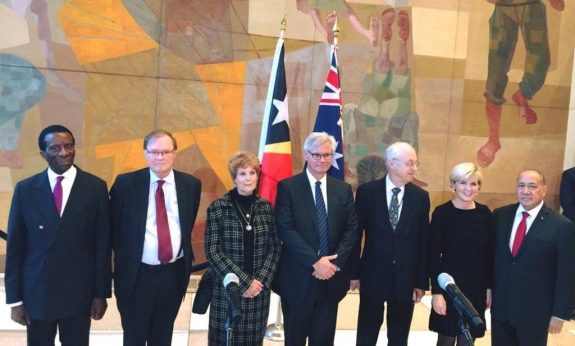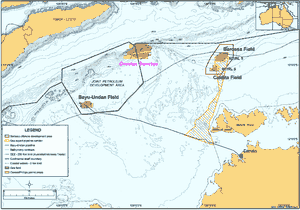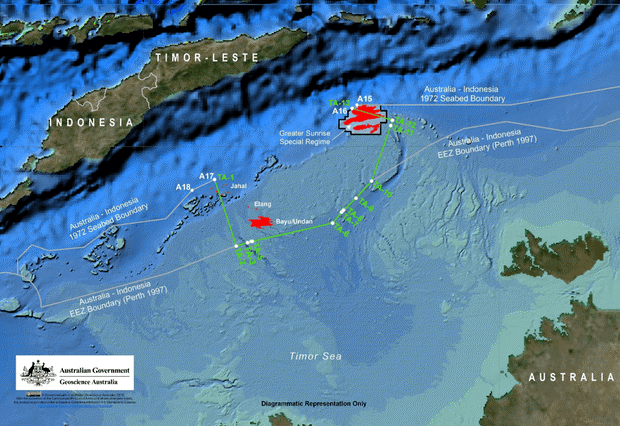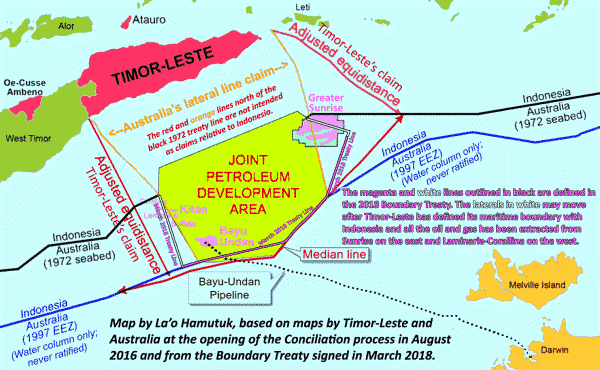The spying on Timor-Leste case … et cetera (part 7)

By Dr George Venturini
(Much of the material in this page is drawn from the work of La’o Hamutuk, the Timor-Leste Institute for Development Monitoring and Analysis, which has monitored and campaigned for Timor-Leste’s rights for two decades. For more detailed information on this and related issues, see www.laohamutuk.org. Current and updated information on the maritime boundary dispute with Australia is at https://www.laohamutuk.org/Oil/Boundary/18ConcilTreaty.htm).
On 1 September the Permanent Court of Arbitration issued a press release celebrating a ‘breakthrough’ in the conciliation process, announcing that “Timor-Leste and Australia have reached agreement on the central elements of a maritime boundary delimitation between them in the Timor Sea. The Parties’ agreement constitutes a package and, in addition to boundaries, addresses the legal status of the Greater Sunrise gas field, the establishment of a Special Regime for Greater Sunrise, a pathway to the development of the resource, and the sharing of the resulting revenue.” (‘Conciliation between the Democratic Republic of Timor-Leste and the Commonwealth of Australia, Timor-Leste and Australia Achieve Breakthrough in Maritime Boundary Conciliation Proceedings,’ Copenhagen, 1 September 2017).
But there remained sceptical voices on the substance of the ‘breakthrough’: Kim McGrath, ‘Maritime deal between Australia, Timor-Leste cautiously welcomed by analysts’ (S.B.S., 3 September 2017; A. Macdonald-Smith, ‘Sunrise gas hopes stirred by Timor-Leste se border dispute breakthrough’, The Australian Financial Review, 3 September 2017.
Timor-Leste was confident enough to report “decisive” progress on the issue to the U.N. General Assembly, (‘General Assembly of the United Nations, General Debate, Timor-Leste, H.E. Mrs. Maria Helena Pires, Permanent Representative to the UN,’ 25 September 2017) and the Timor-Leste Government congratulated the Australian Prime Minister Malcolm Turnbull on his “commitment to strengthening the special bond that unites both countries.” (‘Prime Minister appreciates Australia’s willingness to strengthen ties with Timor-Leste,’ 26 September 2017).
As the newly-elected Fretilin-led government in Dili took shape, Prime Minister Mari Alkatiri appointed Agio Pereira as Deputy Prime Minister for the Delimitation of Borders. Xanana Gusmão would have continued to lead the negotiations, and Pereira – his long-time right-hand man – would keep the government informed.
At the swearing-in ceremony for Pereira and other new Ministers on 3 October, Prime Minister Alkatiri stressed the importance of this issue: “With regard to sovereignty, I reiterate the position of my Government, and on behalf of all, to fully support to our negotiating team on the maritime and land borders of Timor-Leste. His Excellency Kay Rala Xanana Gusmão, and the team he heads, will always formally recognized, legitimized and supported by this Government in the noble mission to negotiate on behalf of the State of Timor-Leste our maritime and land borders with our neighbours. We begin today to institutionalize this support with the swearing in of His Excellency the Deputy Prime Minister for the Delimitation of Borders.” (‘DISCURSO DE SUA EXCELÊNCIA O PRIMEIRO-MINISTRO DA REPÚBLICA DEMOCRÁTICA DE TIMOR-LESTE, DR. MARI ALKATIRI, NA CERIMÓNIA DE TOMADA DE POSSE DE MEMBROS DO VII GOVERNO CONSTITUCIONAL, Palácio Presidencial Nicolau Lobato 03 de outubro de 2017 – Speech by H.E. the Prime Minister of the Democratic Republic of Timor-Leste, Dr. Mari Alaktiri, at the swearing-in ceremony of the ministers of the seventh constitutional government, Presidential Palace Nicolau Lobato’, 3 October 2017).
Agio Pereira explained the situation (‘Timor-Leste and Australia seek agreement on maritime borders’,4 October 2017) and updated the new Council of Ministers at their meeting on 4 October: “The continuity of the State is part of the existence of this same concept. From it arises the need to develop a solid culture and institutional state life.The permanent boundary delimitation of our Territory which includes the Earth, the sea and the air, is an imperative of the full affirmation of our State. Therefore, my government understands the need to create an appropriate institution, a High Authority to manage this issue as important as complex. The High Authority should be seen by all as a solution that guarantees a consistent view of the common interests of our State and of our People.” (COMUNICADO DE IMPRENSA, Reunião do Conselho de Ministros de 4 de outubro de 2017).
The next round of talks took place in the Hague from 9-13 October, and the two countries “reached agreement on a complete draft treaty,” according to a press release from the Permanent Court of Arbitration. Details of the agreement remain secret, but the Woodside-led Sunrise Joint Venture is now part of the process. Conciliation Chair Peter Taksøe-Jensen said that these meeting were the “easiest” so far, and that the two parties spoke directly, no longer needing the conciliators to carry messages between them. (‘P.C.A., Conciliation between the Democratic Republic of Timor-Leste and the Commonwealth of Australia, Timor-Leste and Australia reach agreement on treaty text reflecting 30 August Comprehensive Package Agreement,’ The Hague, 15 October 2017).
On 13 October the Ministers from Timor-Leste and Australia exchanged letters assuring that current financial and regulatory arrangements for Bayu-Undan and Kitan would have remained in effect under the new treaty.
The respective representatives would meet in Singapore in late November, and again in December, in the hope of signing a treaty by early 2018. After that, the Conciliation Commission would have released a public report on the proceedings. The news was widely reported in wire service articles which added little to the press release. (‘East Timor and Australia agree draft maritime border treaty’, A.F.P., 15 October 2017; ‘Timor, Aust talks move to gas field’, S.B.S.A.A.P., 16 October 2017).
It was clearly stated in the proposed Government Programme that: “The delimitation of permanent borders with Australia and Indonesia is a national priority since Timor-Leste, since its independence, legitimately aspires to exercise full sovereignty over the national territory, including the maritime territory which, under the terms of international law, lies within its jurisdiction.” And this was confirmed by the Platform of the Parliamentary Opposition parties. (‘PLATAFORMA POLITIKA ALIANSA MAIORIA PARLAMENTAR’).
In an A.B.C. Radio Report on 17 October Timor-Leste’s Ambassador to Australia Abel Guterres promised that his government would be prepared to sign a new treaty by the end of the year.
On 3 November Prime Minister Mari Alkatiri told the Asia-Pacific Regional Conference in Perth “The Greater Sunrise field can soon be developed now that Timor-Leste and Australia have agreed to a special regime for the joint development and management of the field.” At the conference, Alkatiri and Australian Prime Minister Malcolm Turnbull announced that the Australian government would donate two Australian-built military patrol boats, worth A$30 million, to Timor-Leste. The two Prime Ministers held a summit meeting the following day. (‘Austal to build boats for Timor as Woodside gas deal takes shape’, The Australian Financial Review, 5 November 2017).
On 6 November, an article in The Australian, ‘Sunrise hopes rise as talks begin’, quoted Prime Minister Alkatiri as saying that “everything is on the table,” including the possibility of piping Sunrise gas to Darwin. (P. Garvey, ‘Maritime deal revives stalled Woodside-Timor-Leste gas project, Sunrise hopes rise as talks begin’, The Australian, 6 November 2017).
The article caused much concern.
On 7 November the Prime Minister’s office issued a press release reaffirming the Timor-Leste Government’s “unconditional support for chief negotiator Xanana Gusmão to lead the maritime boundary negotiations and the development of Timor Sea oil and gas.” The Prime Minister said that The Australian’s article had no basis, and that “we firmly maintain our position that the gas pipeline must come to Timor-Leste.” (‘PRIMEIRO MINISTRO,VII Governu Konstitusionál Reafirma Apoiu Inkondisionál ba Xefe Negosiadór, Sr. Kayrala Xanana Gusmão Lidera Negosiasaun Kona-ba Fronteira Marítima no mós Dezenvolvimentu mina ho gás iha Tasi Timór’, Díili, 07 Novembru 2017). The Prime Minister’s office wrote to the newspaper, which printed a clarifying article on 10 November.
On 9 November Petroleum Economist described the connections between Sunrise and the boundary issue. (S. Parker, ‘Setting Timor-Leste’s boundaries’, 9 November 2017).
On 18 November the Journal of International Relations put it in geopolitical context. (M. Carmen Martίn Palacios, ‘The importance of sea geopolitics: the case of East Timor’, 18 November 2017).
The Conciliation Commission, together with Timor-Leste, Australia and the Sunrise Joint Venture, continued discussions in Brisbane in early November and in Singapore on 18 November, as summarised in the Commission’s (‘P.C.A., Conciliation between the Democratic Republic of Timor-Lest and the Commonwealth of Australia’, Press release, The Hague, 23 November 2017).
Timor-Leste and Australia continued engagement with Greater Sunrise Joint Venture and progress towards signature of maritime boundary treaty. However, the specifics of their agreement and draft treaty were still unknown.
On 26 November Australian Broadcasting’s Radio National broadcast a half-hour programme: Battle over the Timor Sea, featuring four Australian academics.
On 16 December it appeared certain that Australia had agreed to sign a boundary treaty.
The Conciliation Commission, through its Permanent Court of Arbitration secretariat, issued another press release on 26 December. The announcement reported that Timor-Leste, Australia and the Sunrise Joint Venture held another round of talks in Singapore during the week of 11 December. Although no additional specifics were revealed, the three parties agreed to a “supplementary action plan” to decide the Sunrise development concept (i.e. where the gas would be liquefied) by 1 March 2018, with a treaty to be signed in subsequent weeks. (‘P.C.A., Conciliation between the Democratic Republic of Timor-Leste and the Commonwealth of Australia’, Press release, The Hague, 26 December 2017).
Timor-Leste and Australia continued their engagement with Greater Sunrise Joint Venture and agreed to the timeframe for signature of the maritime boundary treaty The Commission would have published its report in April 2018.
On 28 December 2017 the A.B.C. reported that Bernard Collaery, who had represented Timor-Leste on the boundary issue, believed that the treaty deadline could be “wishful thinking”, given the political uncertainty in Dili and the possibility of new elections.
On 13 January 2018 chief negotiator Xanana Gusmão addressed the World Energy Forum of the Atlantic Council in Abu Dhabi about ‘Lessons from Timor-Leste on Best Practices and Sustainable Economic Models’. He spoke about the resource curse, the Petroleum Fund, the maritime boundary conciliation and the Tasi Mane Project. Although Xanana Gusmão has been active in the boundary conciliation process and speaking at conferences around the world, he has not been back in Timor-Leste since September.
On 26 January President Lu Olo dissolved Parliament and ordered new elections, which were to be held on 12 May. Some Australian media lamented that this could have delayed the signing of the maritime boundary treaty, a strange view in light of the Australian intransigence which delayed agreement on maritime boundaries for decades. Prime Minister Mari Alkatiri expressed confidence that the agreement would have been signed soon, and, a few days later, it was reported that the signing would have taken place on 6 March in New York in the presence of the U.N. Secretary-General Antonio Guterres. However, it remained unclear who would have signed for Timor-Leste, because Xanana Gusmão had not yet been sworn into his position in the new Government. Prime Minister Alkatiri said that Gusmão would be the most appropriate signer, but if he had not taken up his position, Deputy Prime Minister Agio Pereira, who had been the second-ranking person on Timor-Leste’s side during the conciliation process, could have signed on behalf of Timor-Leste.
The terms of the agreement were not disclosed until after it was signed in March. It establishes a boundary along the median line, although the eastern and western lateral locations were still secret, and the location for liquefying the natural gas from Sunrise remained unresolved. However, according to reliable sources, Timor-Leste was to receive 70 per cent of the upstream revenues from Sunrise if the pipeline had come to a new LNG plant in Beaçu on Timor’s south coast, or 80 per cent if the gas were to be piped to Darwin, where it would have replaced dwindling gas supplies from Bayu-Undan.

This last option was somewhat uncertain because ConocoPhillips’ Barossa project would also have liked to tap into the Bayu-Undan pipeline and use the Darwin LNG plant. On 8 March, after the treaty became public, ConocoPhillips and Santos began promoting Barossa more assertively, perhaps to pressure Timor-Leste’s Government quickly to agree to Sunrise gas being processed in Darwin.
Another round of talks took place in Sydney during the first week of February, and the parties – now including the oil companies – would have met again in Malaysia on 19-24 February. Sources were confident that the boundary treaty would have been finalised before the Commission’s mandate expired on 1 March, even if the Sunrise development modality had not yet been agreed.
At its meeting on 13 February, Timor-Lestes Council of Ministers approved the text of the maritime boundary agreement which was to have been signed on 6 March in New York. Although Deputy Prime Minister for the Delimitation of Borders Agio Pereira were to sign on behalf of Timor-Leste, Prime Minister Mari Alkatiri and chief negotiator Xanana Gusmão were expected to be present.
It was reported that Bernard Collaery, whose office had been raided by Australian ‘intelligence’ in 2013 while he was representing Timor-Leste, was working on a book about the controversy. A few months later, Australian prosecutors would charge Collaery.
On 17 February it was reported that Timor-Leste was making a ‘last effort’ to bring the pipeline from Greater Sunrise to Beaçu. The final set of meetings organised by the Conciliation Commission, including representatives from Timor-Leste, Australia and the Sunrise Joint Venture oil companies, took place in Kuala Lumpur during the week of 19 February. On 23 February the Australian Embassy in Timor-Leste celebrated its successful conclusion, and on 25 February the P.C.A. issued a press release: Conciliation Commission concludes engagement on development pathway for Greater Sunrise gas fields at final conciliation session with Timor-Leste and Australia. (‘P.C.A., Conciliation between the Democratic Republic of Timor-Leste and the Commonwealth of Australia’, Press release, Kuala Lumpur, 25 February 2018).
According to the release, “the Parties have reached agreement on a treaty which delimits the maritime boundary between them in the Timor Sea and addresses the legal status of the Greater Sunrise gas field, the establishment of a Special Regime for Greater Sunrise, and a pathway to the development of the resource. The treaty also establishes revenue sharing arrangements between the governments of Timor-Leste and Australia where the shares of upstream revenue allocated to each of the Parties will differ depending on downstream benefits associated with the different development concepts for the Greater Sunrise gas field. ‘Having now concluded their respective domestic processes, the two governments have agreed to convene at 5:00pm on 6 March 2018 [at UN Headquarters] in New York for the signature of their new Maritime Boundaries Treaty’.”
As reported by the A.B.C., the details of the treaty and other arrangements had not yet been made public. However, according to information available on 26 February, the decision on where the gas pipeline from Sunrise was to go was being deferred, probably until a new government was formed after the 12 May parliamentary elections.
The following day, the Timor Sea Justice Campaign celebrated the agreement. Over the next few days, many elements of the media published articles about the pending treaty.
However, many writers misunderstood the potential revenues from Greater Sunrise, the role of the Permanent Court of Arbitration, the function of the Conciliation Commission, and the consensual, non-binding, non-legalistic nature of the bilateral discussions between the two countries. On 3 March Forbes published a piece by Damon Evans, titled ‘Overblown Expectations For East Timor’s Greater Sunrise Oil And Gas’, Forbes, 3 March 2018).
On 1 March the Timor-Leste’s Government announced that Prime Minister Mari Alkatiri would not have gone to New York for the signing of the treaty because the Australian Prime Minister Malcolm Turnbull did not plan to participate. Xanana Gusmão would not have attended. The treaty signing and subsequent press conference were live-streamed on UN Web TV The United Nations Live & On Demand on 6 March.
The chief negotiator Xanana Gusmão could not attend the signing of the treaty because he was in Sierra Leone. Nevertheless, he was not invisible: twelve hours before the signing ceremony, someone delivered to the Australian Broadcasting Corporation an eight-page letter he had written to the Conciliation Commission on 28 February 2018. In that letter Mr. Gusmão reproached the Commission’s “lack of impartiality” for comparing the Darwin and Timor LNG options, and for rejecting Timor-Leste’s input while colluding with the oil companies. The A.B.C. ran a news article and a radio report on the letter. (A.B.C., Peter Lloyd, ‘East Timor accuses Australia of colluding with companies over Great Sunrise oil and gas deal’, 6 March 2018).
A few days later, The Australian accused Xanana Gusmão’s Timor Sea [of a] rant is an own goal for his needy nation. (C. Stewart, ‘Xanana Gusmao’s Timor Sea rant is an own goal for his needy nation’, The Australian, 10 March 2018. In fact, Mr. Gusmão returned to Timor-Leste on 11 March, after being away for nearly six months.
On the eve of the signing, many journalists wrote on the new treaty’s impact on the Australia-Indonesia border (A.B.C., A. Barker, ‘Australia and East Timor maritime agreement could ‘unravel’ border with Indonesia’, 6 March 2018).
In fact the agreement would have closed the door on the long and bitter dispute between Australia and Timor-Leste over their maritime boundary, despite difficulties with the Sunrise gas project, and brought about the resolution of bitter differences. There was an optimistic view of Jose Ramos-Horta’s: ‘Ramos-Horta saúda tratado entre Timor-Leste e Austrália mas recorda necessidade de fundos, Ramos-Horta welcomes treaty between Timor-Leste and Australia but recalls need for funds’, noticias.sapo.tl, 6 March 2018.
The treaty would have signalled the end of decades of acrimonious talks (H. Davidson and C. Knaus, ‘Australia and Timor-Leste to sign deal on contentious gas field’, The Guardian, 6 March 2018).
It was noted, though, that “the new deal replace[d] previous attempts at treaty torn up after it emerged Timorese negotiators had been bugged.” That was something which would not go away soon – possibly, ever and certainly not in a short time, as will be seen.
The Treaty between Timor-Leste and Australia Establishing their Maritime Boundaries in the Timor Sea was signed by Ministers from the two countries in New York on the afternoon of 6 March 2018, in the presence of U.N. Secretary-General Antonio Guterres, Conciliation Chair Peter Taksøe-Jensen. Foreign Ministers Julie Bishop and Agio Pereira spoke at the signing and then held a press conference. (‘Maritime boundary treaty signing press conference with Timor-Leste’, Transcript, E&OE, United Nations Headquarters, New York, 7 March 2018).

The new Australia-Timor-Leste border agreed on in March 2018. Photograph: Geoscience Australia
The following was to become the official map based on the treaty.

Some of the boundary lines, particularly the northern parts of the lateral boundaries, were to be adjusted after Timor-Leste and Indonesia have settled their maritime borders. However, they will stay as shown on the map until the relevant oil and gas fields (Laminaria-Corallina and Greater Sunrise) have been emptied and decommissioned. Once the treaty would enter into force, Timor-Leste was to receive 100 per cent of the government take from Bayu-Undan – and Kitan, if and when it restarts production. However, none of the more than $2 billion that Australia had already received from those fields will be paid back to Timor-Leste, even though Australia no longer claims sovereignty over those areas (H. Davidson and C. Knaus, ‘Treaty confirms Australia profited from Timor-Leste oil and gas, rights group says’, The Guardian, 7 March 2018) In fact, the agreement stipulates that there would be ‘no compensation for past exploitation.’
The border line passes through the unitised Sunrise area in an arbitrary location, chosen to represent that approximately 70 per cent of the field is in Timor-Leste’s territory and 30 per cent in Australia’s. However, management of field would remain shared between the two countries.
The two governments issued a joint press release. (‘Minister for Foreign Affairs. Australia, The Hon Julie Bishop M.P., Minister in the Office of the Prime Minister for delimitation of borders and Agent of the Conciliation Process, Democratic Republic of Timor-Leste H.E. Agio Pereira and Chief Negotiator for the Council for the final delimitation of maritime boundaries, Democratic Republic of Timor-Leste H.E. Kay Rala Xanana Gusmão’, Join media release, 6 March 2018).
On the same day of the signing of the treaty, The Guardian reported that Witness K, who had initially revealed Australian ‘intelligence’ eavesdropping during the C.M.A.T.S. negotiations, remained under ‘effective house arrest.’ Mr. Colleary said that Australia’s refusal to grant Witness K a passport was ‘pure retaliation’. On 22 March José Ramos Horta called on Australia to return his passport. Instead, three months later Australian prosecutors brought criminal charges against him.
Continued Wednesday – The spying on Timor-Leste case … et cetera (part 8)
Previous instalment – The spying on Timor-Leste case … et cetera (part 6)
 Dr. Venturino Giorgio Venturini devoted some seventy years to study, practice, teach, write and administer law at different places in four continents.
Dr. Venturino Giorgio Venturini devoted some seventy years to study, practice, teach, write and administer law at different places in four continents.
Like what we do at The AIMN?
You’ll like it even more knowing that your donation will help us to keep up the good fight.
Chuck in a few bucks and see just how far it goes!
Your contribution to help with the running costs of this site will be gratefully accepted.
You can donate through PayPal or credit card via the button below, or donate via bank transfer: BSB: 062500; A/c no: 10495969









